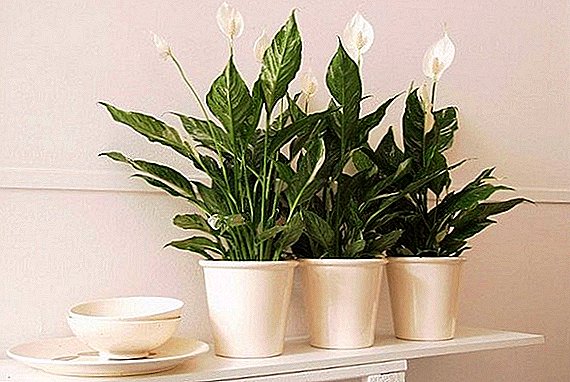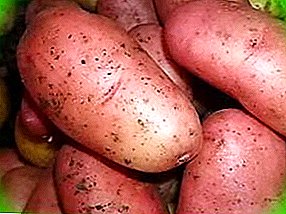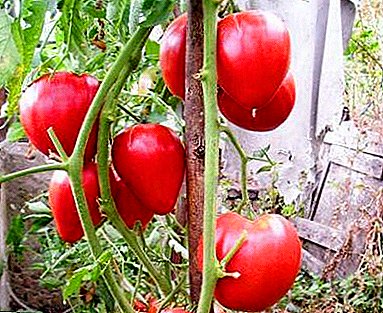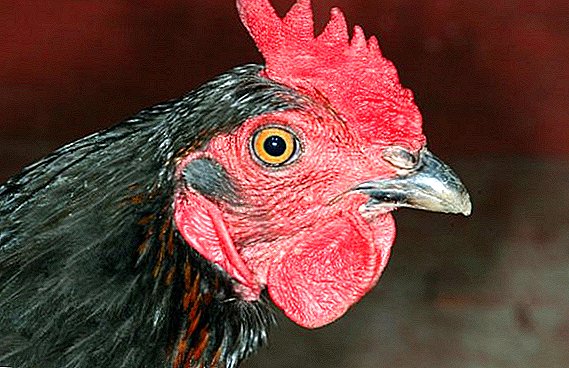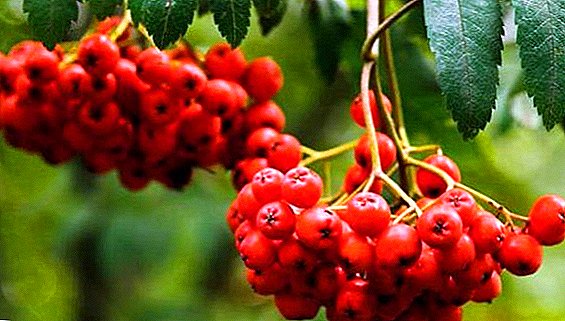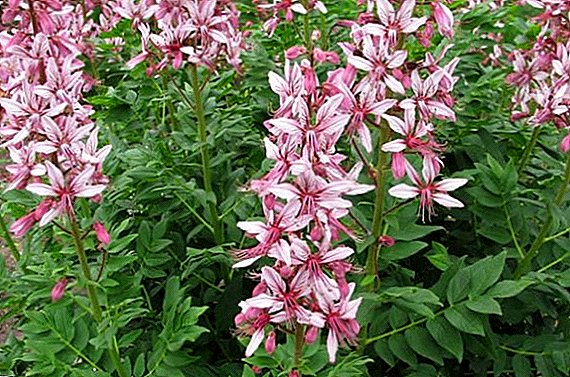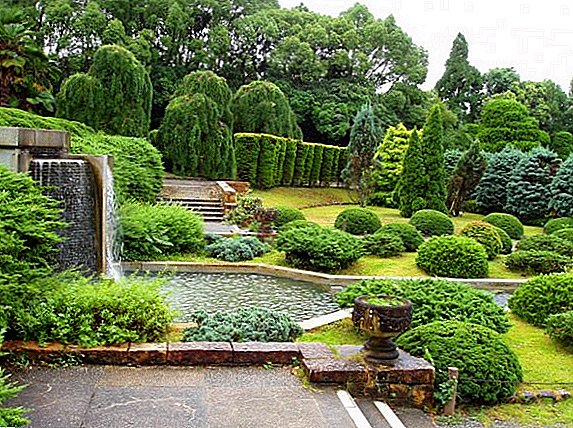 Evergreens in landscape design will be a real highlight of the suburban area.
Evergreens in landscape design will be a real highlight of the suburban area.
With them, giving even in the dull autumn and frosty winter days will not lose its charm and attractiveness.
However, evergreens not only refresh the garden in winter, but with their help you can zone the site, create hedges, sculptures. In this article you will learn about the most popular evergreens and the secrets of creating landscape beauties.
Spruce
Evergreen conifers are one of the most popular in the design of the suburban area. The most common types of fir trees, which are well suited for growing in the country - European and prickly.
European spruce in height it can reach up to 30 meters, and in width its crown is spread over 5 meters. The shape of the crown - conical. By 10 years it grows slowly, then it can grow as much as 70 cm in a year. 
The most popular decorative varieties of this type are:
- "Acrocon" - about 3 m high and 4 m wide, has dark green needles, at the bottom of the crown spreads widely and significantly narrows to the top;
- "Inverse" - it is also called weeping, because the branches fall from top to bottom, like those of a willow; in height can grow up to 7 m;
- "Maxwell" - dwarf variety, has a spherical shape, yellow-green needles, in height and width reaches no more than 2 m;
- "Tompa" - very beautiful dwarf variety, fascinating bright green decorative crown with a light green tint; in height reaches up to 1.5 m, in width - up to 2 m.

Spruce spinyin the absence of trimming, the height can grow to 25 meters. It has an attractive, lowered crown. The needles of this species are very sharp, may be green, blue, gray. Prefers well-lit places, loose moderately moist soil.
Among the decorative varieties most popular:
- "Fat Albert" - grows to 10-15 m, needles of gray color;
- "Fastigiata" - Blue spruce with narrow conical crown;
- "Guspi" - has a very beautiful bright blue needles. It grows up to 11 m.
Important! The first two weeks after planting, young seedlings need pritenyat from the sun, so they do not burn out. Saplings of decorative varieties are also recommended to cover in the fall from the coming frost.The roots of the firs do not grow deep into the ground, but expand in breadth close to the soil surface. Therefore, it is necessary to maintain a distance of at least 3 meters between the trees. Do not place such plants near fruit trees.

Firs do not like too moist soil, so they should be watered only in drought, once every 10 days. The crown of spruce lends itself well to pruning, so that beautiful figures can be formed from it.
Evergreen Honeysuckle
Honeysuckle is one of the most charming evergreen shrubs for the garden. Throughout the summer period, it blooms with beautiful crimson buds, and in winter it pleases the eye with rich green foliage.
Honeysuckle bushes - curly, in height can grow up to 3 meters. The plant has a wide foliage oval. The leaves are up to 8 cm in length, up to 5 cm in width. The inflorescences are odorless, rolled into a tube and hang from the shoots in the form of bluebells about 5 cm long. The color of flowers is mainly dark pink outside, crimson, inside light yellow. In addition, there are varieties with red and yellow buds. After flowering, small bright red berries form on the shoots.
In the open ground, young seedlings are planted in the spring, after the end of winter frosts. The plant loves open, lighted, windless places. The most suitable soil will be loose, moderate moisture soil.
For planting, dig a hole up to 40 cm in depth (it is recommended to lay a layer of sand and gravel on the bottom, then some soil mixture). The plant is placed in the center of the fossa, gently straightening the roots, covered with soil and slightly compacted. Honeysuckle can not be deeply buried in the ground (the neck of the root must be at the level of the ground), otherwise it will not grow and may be lost. The young seedling of the first 14 days should be pritenyat from sunlight. 
Did you know? To honeysuckle bushes looked decorative and neat, its branches must be tied up, and the old - periodically remove to the very roots. With proper garter and strong support, branches of evergreen shrubs can be wrapped around a gazebo or fence.It is recommended to cover bushes for winter. Honeysuckle tolerates replanting and practically does not get sick with anything. Every three years shrubs need thinning.
Cypress
The evergreen cypress hedge just can't fail to fascinate the look. In height trees can reach from 1 to 25 meters. The crown is round and cylindrical. In the second year of growth, cypresses ripen cones. They have a very beautiful shape and resemble a flower bud.
Today, there are about a hundred species of cypress trees, but the most decorative representatives include:
- Evergreen cypress;
- Leyland;
- Weeping;
- Sahara;
- Mexican;
- Arizona.
Important! Cypress tolerates only a little shading, and in conditions of full shade the crown of the tree crumbles.

Cypresses are not demanding to the ground, they withstand drought well, but they do not tolerate frost well. If the drought is long - you should water the tree. For the formation of neat bushes in late August, pruning is carried out. In conditions of barren, heavy soil cypress once a year is recommended to feed a three-component fertilizer. The best breeding method is cutting.
Juniper
Decorative bushes for the garden can be created with the help of juniper. Handicraft forms of the plant reach a height of 3 m, tree - from 4 to 12 m. Young seedlings have reddish-brown bark, in adult plants it becomes brown.
Juniper needles are assembled in pairs of several pieces. In addition to beauty, this evergreen plant has an incredibly pleasant smell and very beautiful green buds. In the second year of growth, cones acquire a grayish color and look like berries.
There are many varieties of juniper, but the most decorative and popular include:
- "Montana" - creeping shrubs about 20 cm high;
- "Kolumnaris" - columnar plants up to 50 cm in height, known for beautiful needles with a bluish tinge;
- Blue Arrow - columnar shrubs with blue-gray needles;
- "Mass" - creeping shrubs with bluish-green needles.

Juniper does not need pruning and this procedure should be carried out only in those cases if you want to form a hedge from its bushes. In this case, you need to be very careful, as the branches of the plant grow very long. Propagated by seeds, cuttings and layering.
Did you know? Juniper needles - the leader among antibactericides, and the berries of the plant can be used as a spice for meat or fish, as they give them a delicious aroma and savory bitterness.
Fir
 This beauty fascinates the slender trunk and lush crown in the form of a cone. Unlike other coniferous trees, fir for a long period retains the decorativeness of the lower branches. The bark of plants is smooth, greyish, in some species in old age it can crack. The needles are soft, with rounded ends.
This beauty fascinates the slender trunk and lush crown in the form of a cone. Unlike other coniferous trees, fir for a long period retains the decorativeness of the lower branches. The bark of plants is smooth, greyish, in some species in old age it can crack. The needles are soft, with rounded ends.
A distinctive feature of fir from other coniferous representatives is that its cones grow upwards like those of cedars, and break up on a tree, and its powerful roots go deep into the ground. In total, there are about 50 species and more than 200 varieties of fir.
The most interesting and decorative representatives include:
- Arizona;
- Balsamic;
- Single color;
- Korean fir.
Balsam fir grows from 15 to 25 m. The bark is smooth, brown, the needles are dark green in color with thin white stripes, the cones are purple. Today there are 20 types of ornamental varieties of this species. A very popular dwarf variety "Nana", which is up to half a meter high (in 10 years), up to 1 m wide. The needles have a charming emerald shade. Another thick dwarf fir species, Kiwi, stands out with a beautiful thick green-blue crown.
Cultural form monochrome fir reaches a height of 8 m. The bark is grayish, smooth, blue-green needles, slightly curled upwards. It has about 30 varieties. The most interesting of these are the Archers Dwarf dwarf variety with a thick blue crown and Wintergold, with yellowish needles in young plants, which change their color to green with age. 
Very beautiful varieties of Korean fir:
- "Blue Magic" - dwarf variety with charming blue needles and lots of blue little cones;
- "Eskimo" - with a gray-blue crown, which looks like a pillow, and due to the randomly located branches, this fir is also called the “witch's broom”;
- "Kula" - grows to half a meter, has a beautiful soft green crown, which is slightly flattened on top;
- "Molly" - dark green shrub, reaching a height of 30 cm.
Important! By the first year of wintering, the plant must be covered with coniferous spruce branches. The young sapling is still weak and can not tolerate large frosts.
Ivy
Ivy refers to liana-like curly shrubs. It can reach a height of 30 m. The foliage of ivy is large, about 25 cm in length, and may have a green, yellow, brownish color. In the fall, the plant blooms with yellow-green umbrella-like small inflorescences. The next spring after planting on the ivy black berries are formed.
Did you know? During grinding, ivy leaves emit a muscatel. Due to this property they are used in cooking as a spice or decoration.
 Ivy grows long and looks very impressive. With the help of supports and garters from it you can form beautiful cascades hanging from parks, fences, balconies, a live evergreen pavilion or even a canopy. The plant tolerates shading normally, but develops best in illuminated areas. Loves warm and fertile soil. Ivy is propagated, most often, by cuttings.
Ivy grows long and looks very impressive. With the help of supports and garters from it you can form beautiful cascades hanging from parks, fences, balconies, a live evergreen pavilion or even a canopy. The plant tolerates shading normally, but develops best in illuminated areas. Loves warm and fertile soil. Ivy is propagated, most often, by cuttings.There are a large number of decorative forms of ivy, and the most popular include:
- winter - it is allocated with very large, wide, light green foliage;
- Baltic - the most frost-resistant variety, has small leaves of saturated green color;
- treelike - It is a small upright shrub with beautiful green leaves with silver spots;
- tricolor - in the autumn, the leaves at the edges become charming bright red color;
- fringed - it is distinguished by the fact that the foliage at the edges is framed by a yellow stripe, which in autumn changes its color to red or pink.
Boxwood
Boxwood is an ideal evergreen plant for borders, often using the site’s landscape design. 
Its benefits also include:
- good crop tolerance;
- the possibility of good growth in dark areas;
- the possibility of forming a variety of shapes.
Important! The leaves of the plant are poisonous, so they should never be eaten. After working with the box, be sure to wash your hands.Boxwood is exactly what you need if you want to shape figures from evergreens. With the help of a thick crown and a large number of branches you can make a perfectly flat surface. Complex multilevel shapes are formed with wire frames. The most suitable varieties for this purpose are "Green Gem", "Suffruticosa".

The Garland boxwood is ideal for making bonsai. For the formation of hedges such varieties as "Latifolia", "Rotundifolia" are perfect. With their help, you can create any shape - cones, ovals, cubes, rectangles.
Important! Boxwoods often freeze to death, but to prevent this from happening, in autumn, the soil should be mulched with needles, and tall plants should be covered with sacking.
Pine
Pine trees in landscape design are great for single planting, combining with other evergreen trees (fir, spruce, larch) or alpine hills, and cedar pine trees make excellent “live” rows. For the formation of dense fences - pines are not suitable, as the needles thin out over time and will not allow the creation of a dense monolithic wall. 
Mountain, cedar and ordinary pines are considered the most suitable for cultivation. Weymouth and Vanguir varieties are suitable for regions with small frosts and fertile soils.
The crown is formed by circumcision. It should be carried out in the middle of summer, after the active movement of sap in the tree ends. Branches can be cut as a whole, and to the middle. Spring and autumn pruning is not recommended.
Did you know? If you want more developed lateral shoots, and the main ones were shorter, you need to pinch in the spring. During it, the kidneys on the tops are cut off.Mountain pine is considered the most unpretentious and frost resistant. Today, there are quite a few of its ornamental undersized varieties:
- "Mugus" (a beautiful decorative pine tree, up to 2-3 m high, is distinguished by a bright green crown with a light green hue);
- "Ofir" (has a thick crown with a yellowish tinge);
- "Varella" (it has a very beautiful long needles of rich green color, with its crowns you can form beautiful fluffy balls);
- "Winter Gold" (different sharp needles yellow-green color).
Yew
A distinctive feature of these evergreens is the flat dark green needles and red small cones, which look like berries. It grows for a long time, but can calmly live up to 3 thousand years. Perfectly tolerates shading, does not like polluted air. It grows well on loose soils, tolerates drought well. 
Important! Cones, needles and bark of yews contain toxic substances. They are in no case be eaten. After planting, caring for a tree, touching it, be sure to wash your hands well. It is recommended to exclude contact with the plant of children and pets.There are eight types of yew. The most popular is the yew berry and today a large number of its undersized ornamental varieties are bred:
- "Elegance" - perfect for the formation of hedges and group plantings, a ten-year plant in height reaches one and a half meters, young plants are interesting white-golden needles, which with age changes to green with a yellow border;
- "Semperreya" - frost-resistant variety with bright golden needles, at the age of 10 years, grows to only 50 cm;
- "Horizontal" - the crown of this yew grows very wide, and only 1 meter in height, the needles are light green;
- "Washington" - possesses beautiful curved green needles with a golden border.
Туя
Благодаря густой плотной кроне и пьянящему аромату туи занимают одно из лидирующих мест в ландшафтном дизайне. Today, there are about 100 ornamental varieties of thuja, among which there are both tall and dwarf representatives, with green, golden, yellow-green, bluish, bluish color of needles. These trees are great for trim and decorative haircuts. With their help, you can make out alleys, pavement paths, create evergreen borders and dense fences, 
Thuja varieties are best suited for use in landscape design. Globoza (characterized by a smooth rounded crown, suitable for planting along the sidewalk), "Filiformis" (has a spherical uneven crown with snake hanging branches) Bowling Ball (has a pale yellow, heather-like needles).
Did you know? To preserve the shape of the bushes, for the winter they can be tied with a rope.The choice of evergreen beauty is very large, which makes it possible to realize the most exquisite wishes and fantasies. Evergreens can also be combined: for example, thujas look great with juniper bushes, pines, along with fir and spruce. Green figures, "living" curbs, monolithic hedges and cascades at the dacha will fascinate the eyes and delight all your guests.



